Recently I've been getting weekly messages asking about low histamine protein powders— mainly which ones to try, but also questions related to formulating plant-based low histamine meals.
This can be incredibly difficult, but there are definitely people for whom eating animal products just isn't an option, whether due to ethical or health concerns.
Such situations make the grocery store even harder to navigate, but not impossible. In such cases, formulating your low histamine diet for proper nutritional balancing may require you to supplement with a protein powder, especially in smoothies.
So while we'll touch on a couple of animal-derived protein powders, the bulk of this article focuses on plant-based proteins you can add to your next smoothie or tomorrow's breakfast bowl. You can indeed consume all 9 of the essential amino acids by complementing your diet with a low histamine protein powder in your daily meals.
Medical Disclaimer: as with everything on this site, this article is provided for information only. I strongly urge you to speak with your doctor or a licensed medical professional in order to assess whether or not you have histamine issues, and/or which foods cause a histamine release for you personally. Every body is different, and some people will tolerate different foods than you do. Please keep comments respectful.
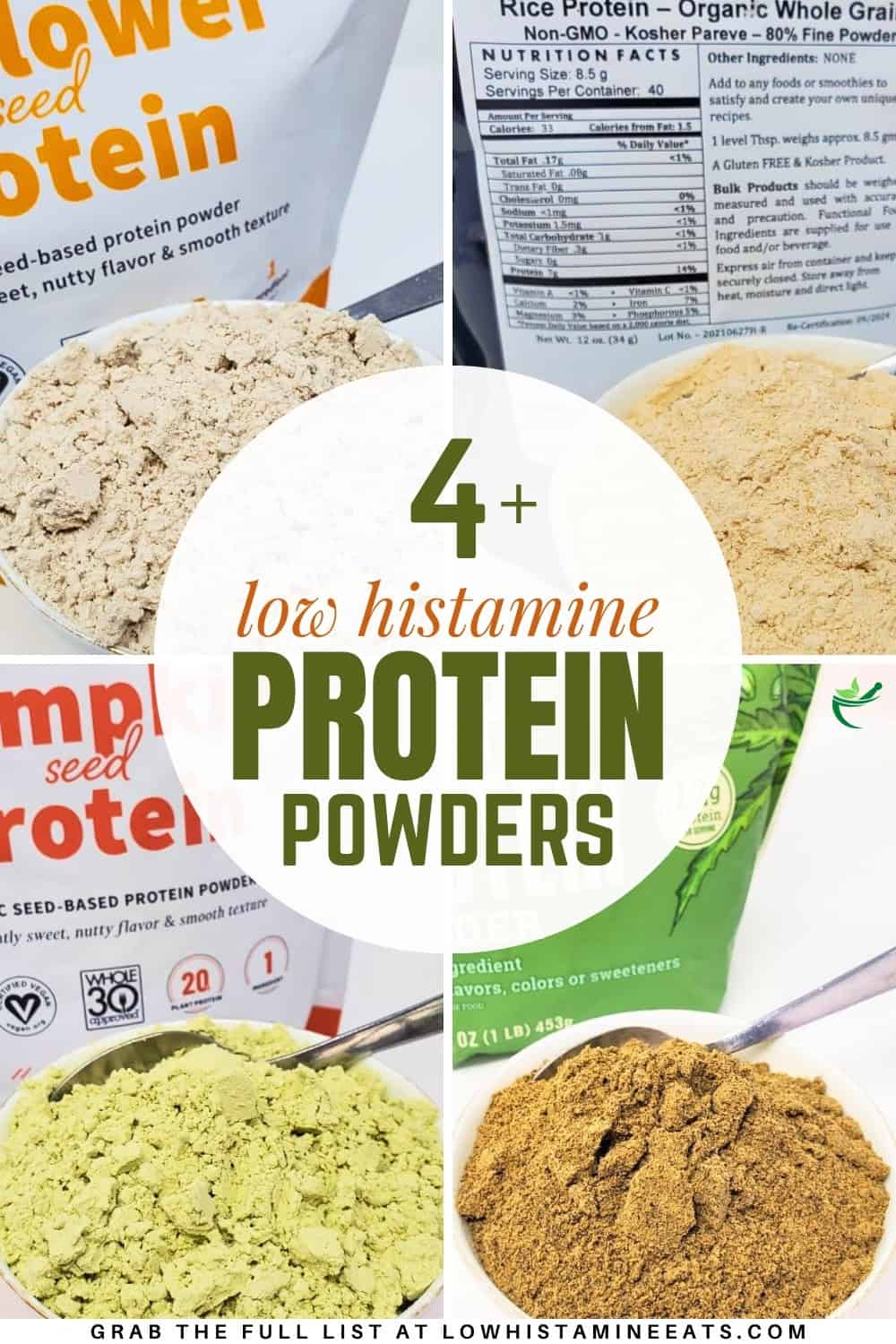
Jump to:
🌱 What Are Low Histamine Protein Powders?
Protein powders contain a variety of antioxidants and vitamins that can strengthen your immune system. Protein is primarily used to produce tissues, improves blood circulation, help you process food, and provide your body with the material needed to produce hormones.
For example, the amino acid lysine absorbs a lot of calcium, is important for protein synthesis, produces hormones, and makes new collagen. Most protein powders will contain these essentials:
- A protein isolate – pea, brown rice, sunflower seed, pumpkin seed, or hemp seed
- Nutritional ingredients – flaxseed, chia seeds, or kale
- Flavor ingredients – vanilla or fruits
- Stabilizers – a blend of guar gum, acacia gum, and xanthan gum to give it texture (there are now a variety of protein powders that don’t contain stabilizers)

These ingredients are ground and then blended together before being packaged, though it's also now become common to find only the protein isolate available for purchase by itself.
A low histamine protein powder isolate is made from a plant that contains some micronutrients along with the major macronutrients: fat, carbohydrates, and protein.
During the production phase, the protein is isolated from the fats and carbohydrates using a method called ultrafiltration. That's when a plant is ground into a flour and then dissolved into an alkaline solution.
The ingredients that didn’t dissolve during this phase are then discarded as waste, and the proteins become solidified during the acidification phase, and are later isolated using a machine in a laboratory.
It’s a common method used to make plant-derived protein solids that end up being roughly 95% protein by weight. Protein powders made from low histamine foods will remain low in histamine because the temperatures aren’t warm enough during ultrafiltration to harbor histamine-producing bacteria.
The main protein powders okay for histamine intolerance include plant-based proteins (hemp, rice, sunflower, pumpkin seed, spirulina), although some people can also tolerate collagen and whey proteins. To help you decide which option is for you, below are the pros and cons for each.
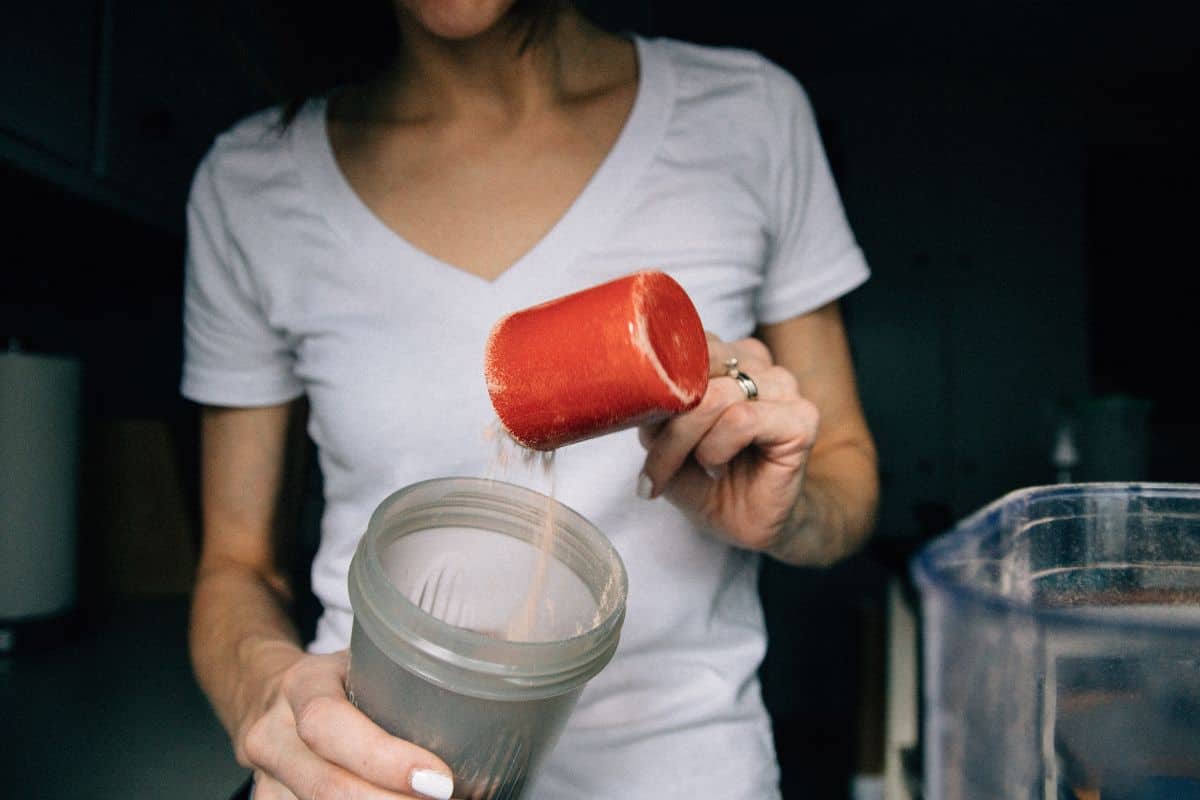
Collagen Protein Powder
Pros
- Reduces rate of bone fracture and osteoarthritis
- Reduces fine lines & wrinkles
- Improves skin elasticity
- Reduces cellulite
- Improves gut health
Collagen protein powder has also been shown to reduce blood sugar response in patients with type two diabetes, according to a study by The International Journal of Biochemistry and Cell Biology. Unfortunately, for those with oxalate issues, collagen powder should be avoided, as it can increase your level of oxalates.
Cons
- Allergic reactions (often contains shellfish and eggs)
- Can cause upset stomach if consumed by itself
- Decreased appetite
- Only contains 8 of the 9 essential amino acids (missing tryptophan)
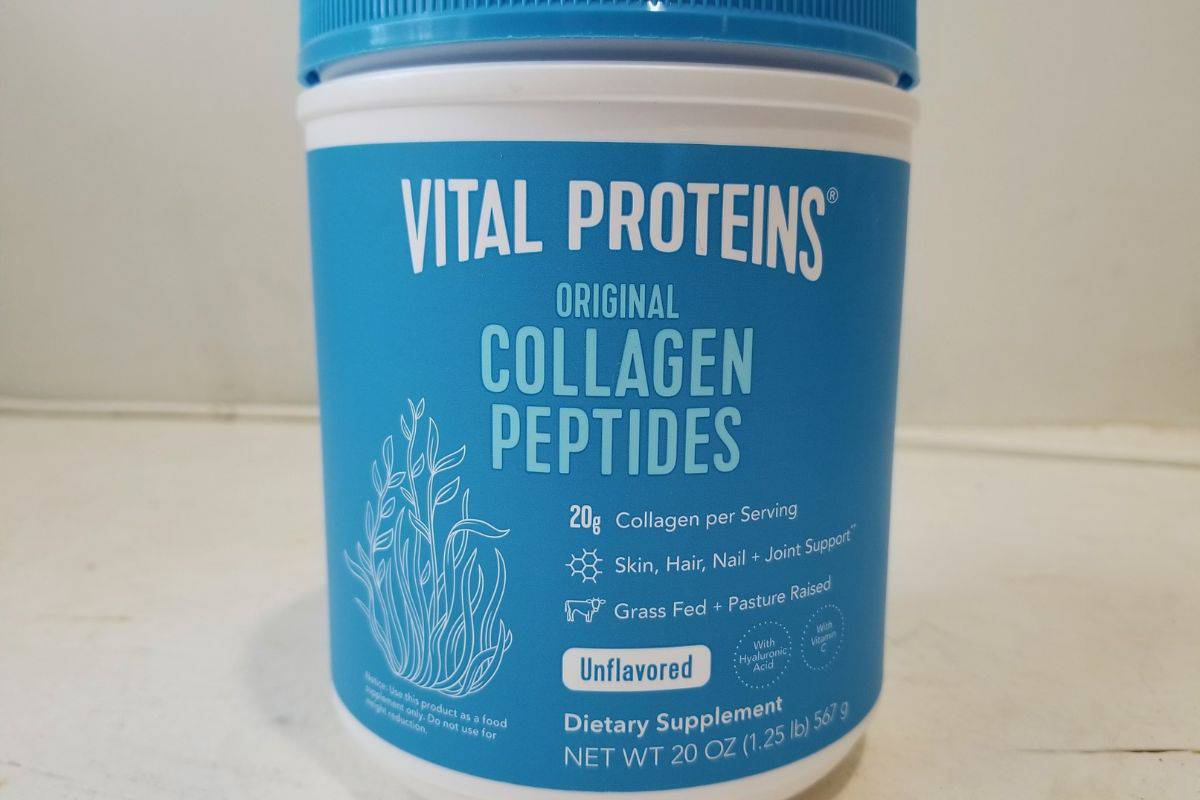
Whey Protein Powder
Pros
- Quick digestion (contains all 9 essential amino acids)
- Improves immune health (directly contains cysteine, which is one of three precursors necessary to produce glutathione, the "master antioxidant")
- Increases muscle tone
Whey protein powder is the best protein source for stimulating muscle growth and repair, according to this study.
Cons
- Contains lactose (common allergen— you can avoid the lactose by only buying "whey isolate")
- Weight gain (consuming large amounts at once will cause the body to store the protein as fat)
- Highly processed (may contain ingredients such as soybean oil, vegetable oil, and artificial flavors, all of which are irritants and may set off histamine issues)
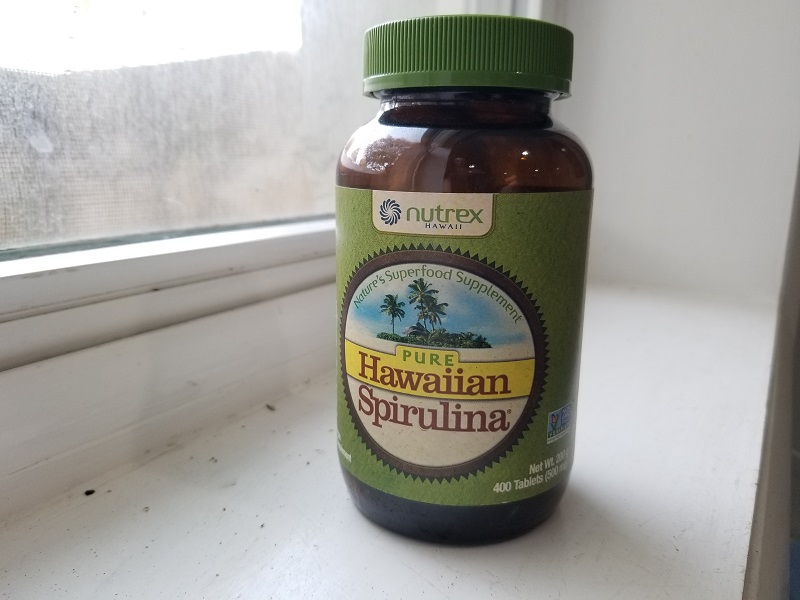
Plant-Based Protein Powders
Pros
- Contain larger amounts of nutrients than animal-derived powders (antioxidants, vitamins, minerals, omega-3 fatty acids, etc.)
- Have notable fiber contents
- Easier digestion
- Safe choice for those who are dairy intolerant
A high quality low histamine vegan protein powder will contain certain plant-based proteins (such as brown rice or possibly pea protein, if green peas don't trigger you) with a sufficient enough proportion of each essential amino acid to meet the requirements recommended by the World Health Organization (WHO).
Cons
- Usually contains a lot of carbohydrates
- Cost more than animal-derived protein powders
- Much lower amounts of vitamin b12 and zinc, common nutrients we get when we eat meat
- Less protein per serving than whey protein powder or collagen
- Don't contain all 9 essential amino acids
- Contain phytate compounds that can reduce the absorption of minerals from the digestive tract
- Pea protein histamine levels are low, but they may still unknowingly trigger the release of histamine

📝 Choosing a Protein Powder for Histamine Intolerance
Let’s look a little closer at the basics of protein powders. Even though protein powders are generally healthy, there are a few ingredients you should avoid, as they may cause a range of symptoms and exacerbate any existing ones.
Strange chemicals, artificial & "natural" flavorings, and any type of sugar should always be avoided; you're here for the protein, after all. So always read the label (or product description) before to purchasing a protein powder, making sure it also doesn’t include:
- Skim milk – a filler with a large portion of lactose (milk sugar), which can cause constipation and bloating
- Casein – can cause bloating and gut distress
- Gluten – can cause inflammation and fatigue
- Maltodextrin and other dextrins – they increase glycemic load, prompting insulin release and and faster fat storage
- Artificial sweeteners – additives such as splenda, aspartame, sucralose, and saccharin cause bloating and weight gain, not to mention interrupting neurotransmitter production
Protein powders come in plain, vanilla, and fruit flavors (I'd avoid the chocolate). If you’d like to disguise the flavor of your powders, then adding frozen fruits, almond milk, spices, and other strong flavors can combat them. You can also add variety to your protein powder by making a smoothie, the recipe of which can change on a whim.

To make your protein smoothie, first pour your milk of choice into a blender. If you’d like a plain creamier taste, choose oat milk, or if you’d like a tropical creamy flavor, then go for coconut milk. Next, add some of your favorite fruits, greens, or root vegetables to increase the antioxidant content.
You can also consume healthy fats for your skin, hormones, and metabolism by adding coconut oil, flaxseed oil, or macadamia nut butter. If you need more fiber, consider adding chia or flax seeds. Finally, pour in the ice cubes and blend to your ideal consistency.
For those who tolerate them, it's also beneficial to get whole food protein from low histamine nuts and seeds, as an alternative to protein powder (even vanilla gets old sometimes!). Nuts and seeds also have even more antioxidants and most of the protein that you'd get from an isolate.
Some of these benefits include essential fatty acids that can improve immune health and neutralize inflammation, as well as 20-25% protein by weight (pistachio and almonds).

❓ Which Protein Powders Are Low Histamine?
There are only four consistently low histamine protein powders I've found: hemp protein, pumpkin seed protein, sunflower seed protein, and rice protein. None of them tastes great; I'll tell you that upfront. But all are very high in protein, as is spirulina, which I also focus on below. Here’s a basic overview of each of these low histamine protein sources.
Hemp Protein Powder
Hemp protein is considered a "complete protein," as it includes all nine amino acids that your body needs but cannot produce on its own. It comes from the ground seeds of the plant species Cannabis sativa, which is related to but not the same as the plants from which pot is harvested.
Throughout the centuries, hemp has been grown for fiber, food, medicine, fabric, paper, and even lamp oil. It contains 12g of protein per serving, meaning that it's roughly half protein. The vitamins and minerals it contains include iron, magnesium, manganese, and potassium.
Some studies have also found that hemp protein is lower in the amino acid lysine, which can be found abundantly in lentils and pistachios, among others; so you may want to add those to your diet, as well. Please note that if you consume large amounts of hemp protein powder, the influx of fiber may cause gas, diarrhea, and bloating.
A serving of hemp protein powder is delicious when paired with these ingredients:
- Hemp-based low histamine protein shake – filtered water or plant-based milk, frozen fruits, carrots or greens, and nut butter
- Hemp protein porridge – plant-based milk, oats, frozen fruits, cinnamon or maple syrup
- Hemp protein waffles – hemp waffle mix, figs, pecans, and maple syrup
- Hemp protein bars – hemp, vanilla extract, nuts, seeds, and nut butter

Pumpkin Seed Protein Powder
Pumpkin seed protein is also considered a "complete protein," as it includes all nine amino acids. However, it's known to be low in the amino of lysine, so it should never be relied upon as your sole source of protein.
The crude powder comes directly from pressing & grinding the seeds of the common pumpkin, thought widely to be a high histamine food, though their seeds are usually well-tolerated. It contains 20g of protein per serving, meaning that it's roughly two-thirds protein by weight.
Side benefits of opting for pumpkin seed protein include the vitamins and minerals it contains, such as magnesium, zinc, and iron. Similar to hemp protein, pumpkin seed protein powder is lower in the amino acid lysine.
This essential amino can be found abundantly in spirulina, lentils, and fenugreek, among others; so you may want to also add those to your diet. Please note that pumpkin seeds also contain a fair amount of fiber, so like any other high-fiber food, introduce it into your diet slowly.

Rice Protein Powder
Rice protein is extracted from the very same rice we cook to pair with our dinner. Rice grains are native to Southeast Asia, and in recent years, scientists have been trying to understand the cholesterol-stabilizing and triglyceride-lowering effects of rice protein.
You get 25g of protein per thirty gram serving, but note that much like hemp protein, rice protein offers decreased proportions of the essential amino acid lysine, so much so that it's not widely considered a complete protein.
All rice proteins contain large amounts of vitamin c and iron, but rice protein that’s sprouted from whole grain brown rice will also have folate, fiber, and other amino acids. However, an important consideration is potential arsenic levels. Rice protein is chronically exposed to arsenic, which is a toxic trace element in the environment.
There are two main types of arsenic, organic and inorganic, but both have negative effects on your health. Inorganic arsenic is the most likely contaminant because it’s found in water and stones. Rice is grown in fields with a lot of water, which makes it easy for the inorganic arsenic to absorb into the plant.
Increased amounts of arsenic cause heart diseases, cancer, impaired cognitive behavior, and diabetes, but with the amount of rice consumed in the western diet, arsenic is only a concern to the most sensitive populations— talk to your doctor if you feel you fall into this category.
One serving of rice protein can be delectably paired with these ingredients:
- Fruit protein smoothie – frozen fruits, filtered water, vanilla powder, and ice cubes
- Rice protein porridge – oats, almond milk, almonds or pistachios, and sliced apricots or peaches
- Rice protein acorn squash pudding – pureed cooked acorn squash, vanilla powder, cinnamon, and maple syrup
- Turmeric latte – coconut milk, rice protein powder, cinnamon, ginger, pepper, flaxseeds, oats, and manuka honey

Sunflower Seed Protein Powder
Like most all other seed proteins, sunflower seed protein is considered a "complete protein," as it includes all nine amino acids your body needs but can't make. It actually comes from the ground seeds of the very same sunflowers that tower over people every summer (at least in the southern USA).
Over the last several years, it's also slowly been becoming better-recognized for the quality source of vitamins, minerals, fiber, and protein that it is. Just like hemp, sunflower seed protein powder contains 15g of protein per serving, so it's just over half protein.
It's a rich source of calcium, selenium, and the powerful antioxidant, vitamin E. Studies show that sunflower seed protein is lower in the amino acid lysine, found in great quantities otherwise in dairy, lentils, pistachios, and spirulina, among others; so you may want to add some of those to your diet.
Note that, as is now a theme, sunflower seeds are high in fiber, and sudden increases in fiber intake can cause gas, diarrhea, and bloating. Add in plant-derived protein powders slowly.

Spirulina Powder
Spirulina is a blue-green algae that grows in saltwater and lakes. It has all the essential amino acids, and you can take as a supplement or blend into your meals. The brightly-colored algae are microscopic water organisms collectively called cyanobacteria.
But the main species recommended as nutritional supplements– with sixty-five percent protein– are Spirulina maxima and Spirulina platensis. Taking 2g of spirulina daily for six months has been proven to improve symptoms such as sneezing, nasal discharge, and congestion in adults with allergic rhinitis.
All types of spirulina contain B vitamins, beta carotene, iron, calcium, magnesium, manganese, potassium, iron, selenium, zinc, gamma-linolenic acid, protein, and a variety of antioxidants.
Spirulina has also been found to be a potent mast cell stabilizer, which can ironically mean that you have to ease yourself into it by starting with daily doses of 500mg, if you're already experiencing histamine toxicity. Potential side effects from too much spirulina may include diarrhea, vomiting, and nausea (and may cause or cure anxiety).
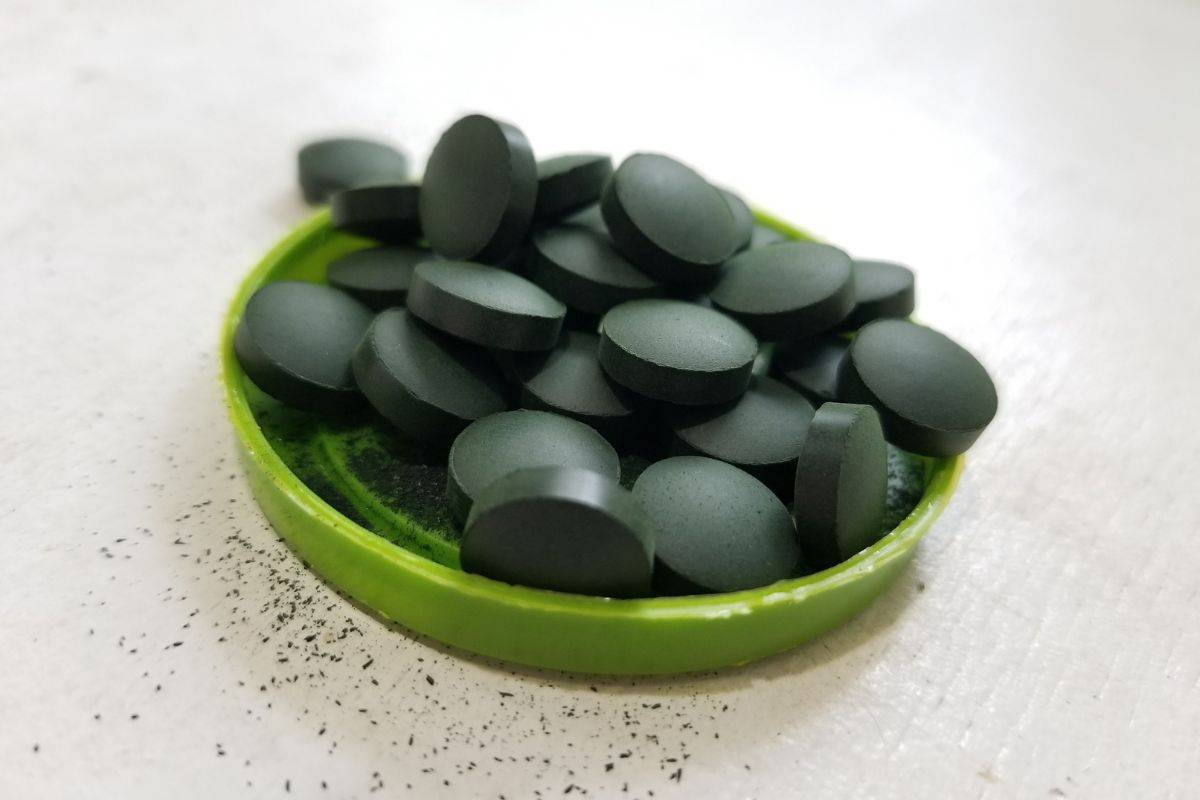
🌿 The Nine Essential Amino Acids
A protein powder must have all nine amino acids to provide you with "complete proteins." Whey protein and spirulina are the only options that have sufficient amounts of all 9 amino acids to be called complete proteins. The nine amino acids are:
- Tryptophan
- Threonine
- Isoleucine
- Leucine
- Lysine
- Methionine
- Phenylalanine
- Valine
- *Histidine (which turns into histamine)
Your body uses amino acids to produce the proteins in your muscles, skin, hair, organs, and tissues. Consuming sufficient amino acids in the form of a protein powder helps you prevent diseases and digest nutrients.
Prolonged amino acid deficiency results in decreased immunity, digestive problems, depression, fertility issues, and decreased mental alertness.
If you decide to consume incomplete plant-based proteins that don’t have all the essential amino acids (rice, collagen, and most other plant-based protein powders) you can make up the deficits with supplements. Get complete protein combinations by mixing incomplete protein powders with:
- Nuts or seeds with whole grains (nut butter and gf breads)
- Whole grains with beans (beans and rice, or hummus and corn chips)
- Beans with nuts or seeds (mixed salad, chickpeas, sunflower seeds, etc.)
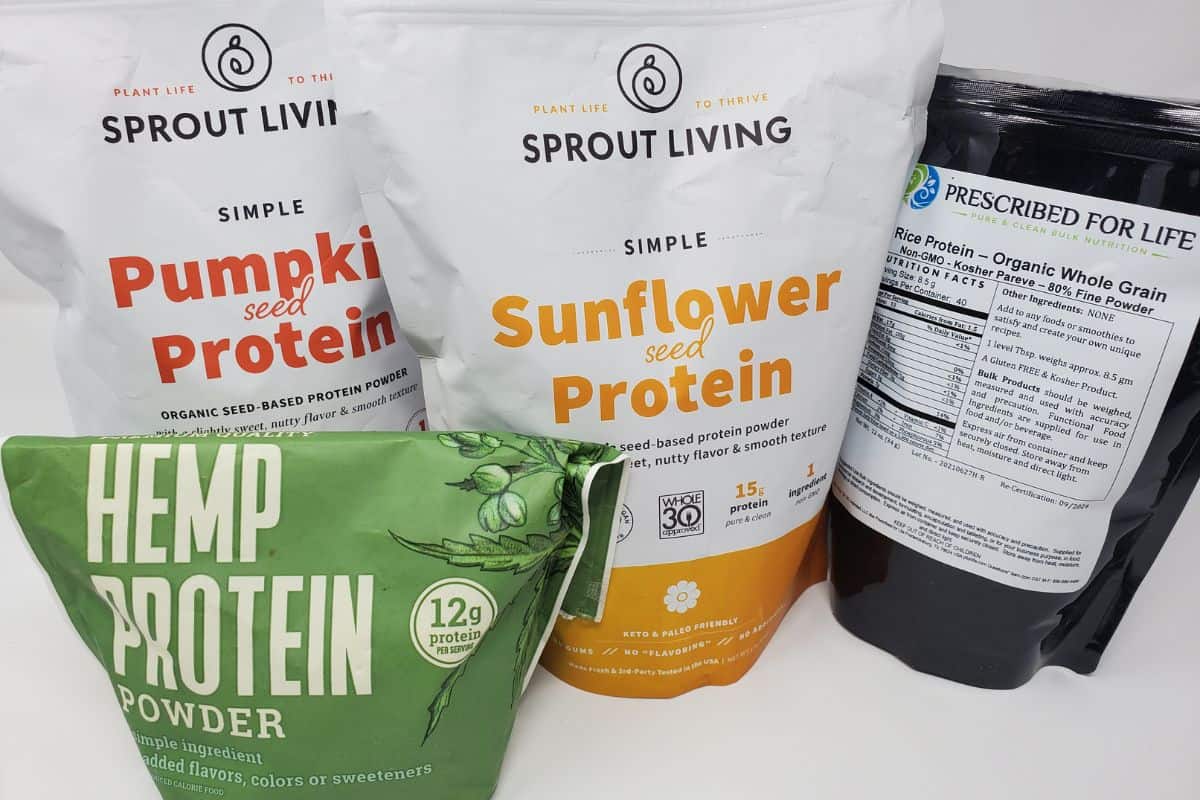
Low Histamine Protein Powder FAQ
Green peas and pea protein are not high in histamine, but they are thought to cause the release of histamine, and should therefore be avoided on a low histamine diet.
Is whey protein high in histamine?
Whey powder is not directly high in histamine, but highly-processed foods like whey powder can still potentially trigger a histamine release.
Yes, hemp seeds are low histamine, and they are a great source of low histamine vegan protein.
There are four types of protein powders that are safe for histamine intolerance: rice powder protein, hemp seed protein, pumpkin seed protein, and sunflower seed protein powders.

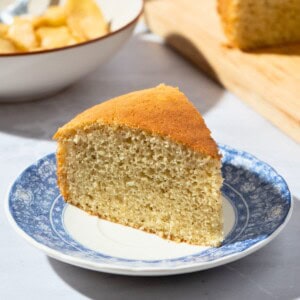












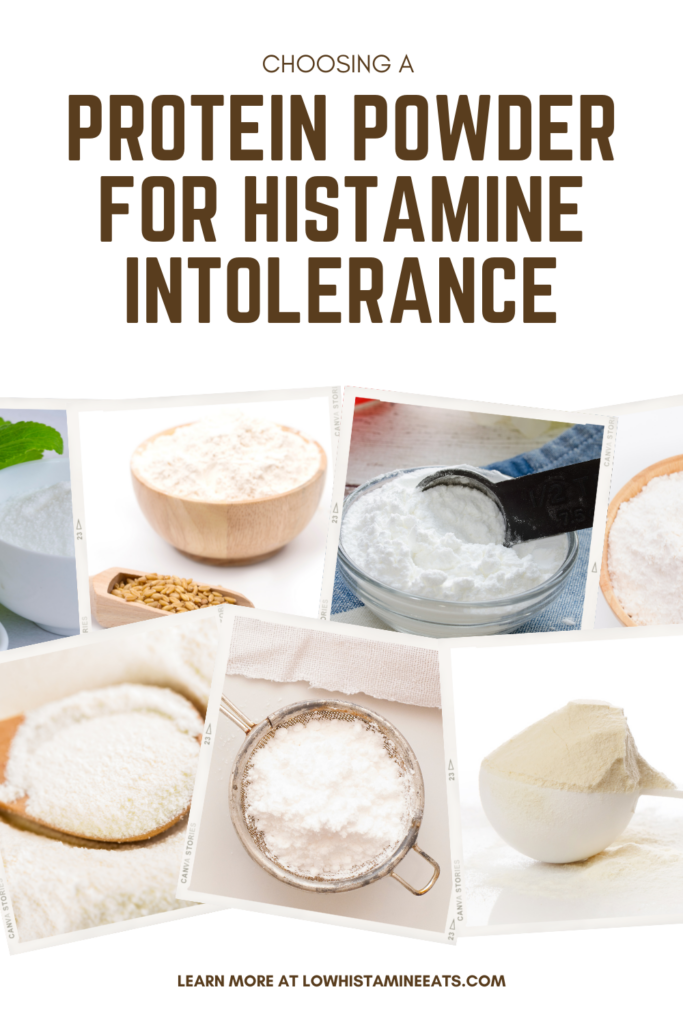

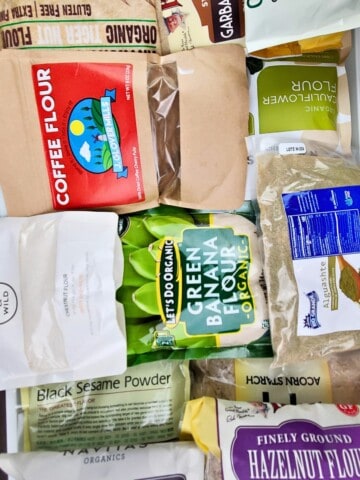
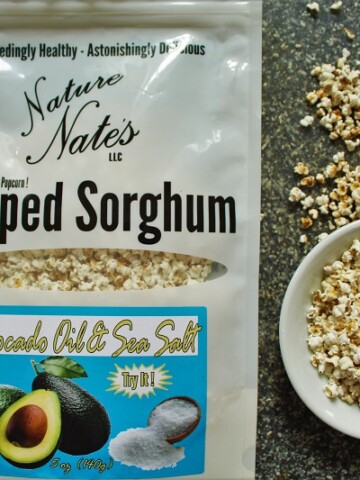
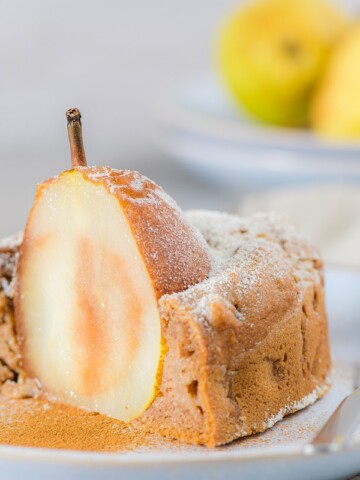
Andy Frog says
Are any of these options low in nickel?
Max says
I'm honestly not sure; I'd write the manufacturer for a question such as that, as it may vary by batch, as well.
Soraya says
Interesting article. A few thoughts: 1. Spirulina being a cyanobacteria can cause difficulty sometimes in people with mold illness. It can act as a binder. 2. Cyanobacteria can cause mast cell issues in destabilized mold patients, I believe.
Max says
Interesting thoughts! I have used both spirulina and chlorella as binders in the past, but I never connected that idea that they could rile up stored toxins for those with mold issues. I'm taking Herbology & Detox next semester, so I'm looking forward to diving more deeply into the mechanisms of that!
Tessa says
I have histamine intolerance and I reacted really badly to the Vital Proteins Collagen Peptide, I would definitely avoid for histamine.
Max says
I'm sorry you've had reactions to it, though that's helpful information to have. I've personally been fine with it (though I haven't used it in months), but another reader mentioned it can up oxalates and in turn affect histamine, which is why I'd recommend most people start with a plant-based powder like hemp or sunflower seed protein. I hope you've been able to find one you tolerate, Tessa!
Jesse Battino says
@Max, Thank yu for all the information! Are there any groups in the northern NJ area that I can meet up with?
Max says
Sorry, I'm not sure what you mean by groups in regards to this article on low histamine protein powders...?
Peter says
Yeah, I thought anything with collagen was high in histamines.
Max says
Collagen is on this list, with its own set of warnings, because not everyone reacts to it (from the feedback I've gotten over the last year, most people dealing with histamine issues tolerate it well). But the connection to oxalate explain why some people react to it while others don't. I've learned that too-high oxalate levels can result in increased histamine, and I suspect that people with a sensitivity to oxalates would not do well with collagen (a good friend of mine with MCAS is like this, and she's actually the one who so strongly recommended I try the Sprout Living seed powders, both of which are low oxalate).
Alex says
Why is collagen on this list? It has been known to trigger reactions in those with histamine intolerance and/or mast cell activation syndrome. It is also high in oxalates due to hydroxyproline content. Oxalates can then trigger histamine release via mast cells.
Max says
To be fair, Alex, everything is known to trigger reactions in those with histamine intolerance and/or mast cell activation syndrome. Collagen is on this list, with its own set of warnings, because not everyone reacts to it (from the feedback I've gotten over the last year, most people dealing with histamine issues tolerate it well). But the connection to oxalate due to the hydroxyproline content is a new one for me, and very interesting. It would explain why some people react to it while others don't. I understand that too-high oxalate levels can result in increased histamine, and I suspect that people with a sensitivity to oxalates would not do well with collagen (a good friend of mine with MCAS is like this, and she's actually the one who so strongly recommended I try the Sprout Living seed powders, both of which are low oxalate). I appreciate you taking the time to leave a comment; I'll add a more detailed warning to the entry on collagen, but I don't want to limit people's choice unnecessarily-- our bodies seem to be doing a good enough job of that on their own!
Sue says
I have been having good luck with almond protein powder, (Bob's red mill). Thanks for all the info!
Max says
Very good to hear-- I didn't even realize that was a product of theirs! I'll have to check it out, and congratulations on the success, Sue!
Michelle says
what do you think of Ka'Chava brand protein powder?
Max says
I hadn't heard of it until now, but just looking at the fact that there are 85 ingredients, I wouldn't take ANYTHING with that many ingredients-- too many possibilities for contamination in the farming or processing or each ingredient, likelihood to trigger a reaction, and just off the bat I saw several high histamine ingredients. You're generally better off starting with single ingredients and working your way up from there.
Jayne says
I have a family member that is severely histamine intolerant after a brain injury (virus) and subsequent hospital icu and massive amounts of prednisone. Her body developed an allergy to progesterone which is a steroid in the body. So the histamine bucket overfloweth every day!
It’s very confusing with the pea protein because she seems to be affected slightly by pea protein milk and went to oat milk because of lactose problem. But trying to find a plant protein that works has been unsuccessful unfortunately. Any beans are out of the question along with soy because of the histamine and hormone issues. So it’s basically eggs, chicken and turkey and rare occasions pea protein foods.
We discovered quercetin for my daughter’s allergy to the progesterone. Then came across freeze dried stinging nettles which worked to block the histamine better than quercetin and it’s a wonderful super food. The problem is that it had to be taken every 3-4 hours but it did work. Also no worries about overdosing.
Next I discovered the amazing properties of Nigella Sativa or black cumin seed. Organic and cold pressed oil capsules twice a day (1000mg total) completely is taking care of 90% of the histamine issues unless my daughter doesn’t eat clean! It’s been the best thing ever for even my allergies. It completely works and it’s not very expensive!
Thank you for all the information. Very helpful.
lowhistamineeats says
You're very welcome, Jayne, and I'm so sorry to hear about your family member's struggles; it's always tough to see loved ones suffer. Have you tried hemp protein, before? It's a seed rather than a nut.
But I'm so glad that you've found some antihistamine foods that your daughter can tolerate, and natural ones at that. I hope you continue to find helpful info on here; I'm working on a lot of LH recipes this month!
Sarah Jupp says
@Jayne, hello thank you for sharing your info. I’m at my wits end, my histamine issues started in peri menopause. I was interested to hear your comments about the progesterone link! I hope your daughter is feeling better. Could you recommend a brand of black cumin seed oil? Only I have exhausted all my savings paying for ‘tests’ specialists with no major improvement and would like to try it. Thanks again 😊
Max says
Just to chime in a bit, @Sarah, NOW Foods has a Black Cumin Seed Oil. I haven't used that one, but I've used their nigella seeds and tulsi powder, and both were good. Hope this helps!
Bolo says
I'm looking for post covid low histamine diet to help with inflammation. Keeping my bodyweight up. Your info is much appreciated. Mahalo Bolo
lowhistamineeats says
I'm sorry you're dealing with all that, Bolo, but I'm glad to be of help. I hope this brings back some normalcy!
Sheldon says
Why is spirulina on this list. From what I'm seeing it isn't really a protein powder. Is this just something you are recommending to take for histamine intolerance in conjunction with the other said protein powders or am I completely misunderstanding. I'd appreciate your feedback and clarity on this. Thank you
Sheldon says
To add, I understand spirulina has protein and the 9 essential amino acids. But from what im seeing online (again correct me if im wrong) one 500mg dose of spirulina only had about 1-2grams protein which is so minimal compared to all the other options. Could you clarify to me why spirulina is on this list, im pretty sure im misunderstanding. Thank you for your time.
lowhistamineeats says
Hi, Sheldon! The main reason spirulina is on this list is because so many people have asked me about it for both use as a supplement for histamine intolerance, and as to whether they could use it in place of animal proteins, and I wanted to have one place I could point both parties. Many people take 3-6g of spirulina a day as a supplement for allergic rhinitis (stuffy nose, itchy eyes, etc., usually due to pollen allergy), and this provides around 2-4g of protein, but this is an amount that people need to work up to, as it can be too overwhelming if your body is already going haywire with histamine production. So to clarify, yes, it is mainly on the list because it is a good additional protein source to use in conjunction with hemp or rice protein, but would NOT be recommended to take as your only protein source (but nor would I recommend hemp or rice as your only source of protein).
Sheldon says
Okay I understand now. Thank you so much for your response. This article has been very helpful and informative to me. Have a good day and keep up the great work!
lowhistamineeats says
It's no problem-- I'm glad to help. And a good day to you, as well!
Charmaine says
Is pea protein on its own high in histamine? From what I’ve read peas are high histamine but yellow split peas which pea protein is said to be made of are low histamine. It becomes confusing.
lowhistamineeats says
No, pea protein and rice protein powders are the two types of low histamine protein powders, so pea protein IS low histamine. However, I know that it's used as the base in a lot of meat substitutes, and I cannot speak to whether how they treat that pea protein will KEEP it low histamine, if that makes sense. I know it's totally confusing, but what's most important is finding out what works for you, and that probably means starting with the most innocuous version of each food-- peas. Then pea protein powder. Then pea protein, prepared with other ingredients you already know you can tolerate. It can be a slow process, but I promise it's worth it!
Kathryn says
This was very helpful, thank you!
lowhistamineeats says
You're very welcome, Kathryn!
Bunny Joy says
I would like to know whether or not there is a "dark sprouted" pea sprout protein powder. From what I've learned pea sprouts contain high levels of DAO enzyme. Completely "dark sprouted" contain as much as 5x the amount. Wouldn't it make sense to use this for histamine intolerance especially for those of us who can't tolerate any meat or dairy products? Just don't know if they make such a product and if not why not?
lowhistamineeats says
Unfortunately, fresh pea sprouts have a very high water content, unlike the matured peas from which they extract pea protein powder, so I imagine that if they were to make protein powder from pea sprouts, it would cost exponentially more. Add to that the extra resources needed to make "dark sprouted" pea sprouts, and I imagine it would be incredibly expensive to make, and beyond accessibility to buy.